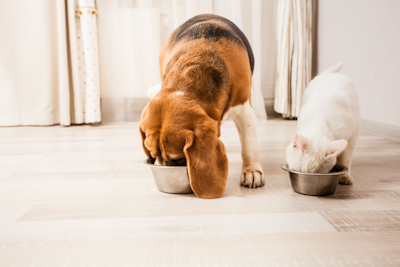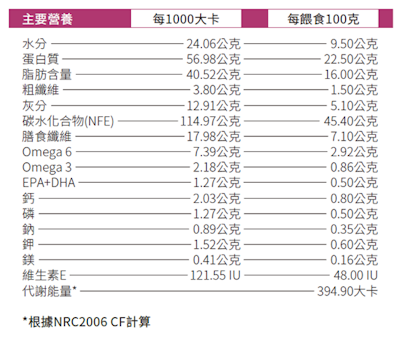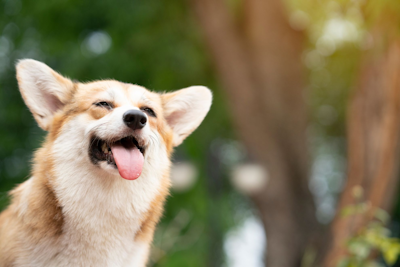Through this article, you will be able to:
【Click and jump to specific section】
Selecting an appropriate diet for our beloved pets is crucial as it directly affects their health conditions. With an extensive array of pet food products, plus various divine formulas available on the market, it is undoubtedly a perplexing task. When it comes to choosing the ideal diet for our cats and dogs, besides satisfying their hunger, it should also tailor to their specific life stages or needs (such as medical needs).
Step 1: Read Through the Ingredient List
The primary goal is to provide the five essential nutrients: protein, fat, carbohydrates, minerals and vitamins, ensuring that these are proportionally balanced to maintain health. Emphasis should be placed on whether the diet delivers an appropriate nutrition profile instead of the costliness of the ingredients.1. Primary Ingredient Source
Referring to the English ingredient list, look for terms such as "Meat", "Poultry", or "Meal". "Meal" refers to dehydrated animal protein, which can often be a higher-quality source of animal protein.
Many pet owners may have negative associations with ingredients that include by-products such as organs, but it is important to note that organs, as a source of animal protein, actually contain rich nutrient profiles. Companies like Royal Canin use human-grade ingredients, with promising quality control.
2. Select the Appropriate Formula Based on Specific Needs
Pets suspected of having food allergies can consider formulas with "hydrolyzed protein" or "single protein" ingredients. For overweight pets, opt for foods that combine various "natural fibers" and have higher protein content to increase satiety.

To clarify a common myth among pet owners: Many foods are marketed as "grain-free = hypoallergenic.", however, according to the announcement of American Veterinary Medical Association, for pets suffering from food allergies, 85% of their allergen is found in animal proteins, while only 15% are attributed to other ingredients. Therefore, "grain-free" does not necessarily mean they are carbohydrates-free or equate to a high protein ratio. To address allergies, you must identify the specific allergen, and since allergens vary among individuals, even feeding grain-free food will not cure allergies.
3. Whether to Incorporate Preventive and Specialized Components
Certain pet foods incorporate ingredients suitable for "adjuvant therapy", which are of the same ingredients as the prescription diets suggested by veterinarians. High-quality prescription diets are designed to provide necessary nutritional support within safety limits, aiming to provide nutritional support to pets with various medical conditions.
Let's take fish oil as an example, the essential Omega-3 fatty acids can help to enhance conditions caused by degeneration. When used in conjunction with medications, it can significantly benefit pets dealing with issues like cancer or unexplained inflammation, particularly essential to skin and gastrointestinal tract). That is why Omega-3 is commonly found in pet food.
Furthermore, some prescription pet foods exhibit professional certification indicators on their packaging, such as the S/O index. This index is achieved by meticulously adjusting the variety of protein types and specific mineral combinations, leveraging the unique properties of various ions. This precise balance ensures that your pet's urinary tract remains less prone to crystal or stone formation, effectively supporting the health of their lower urinary system.
4. Avoid harmful artificial additives
The excessive use of chemical preservatives can pose potential health risks to our pets. Select products that incorporate natural alternatives like Vitamin E, Vitamin C, and antioxidants derived from plants such as green tea and tomatoes. As such, it's strongly advised to choose brands that adhere to international food safety regulations, placing food safety as the utmost priority.
Step 2: Review the Guaranteed Analysis

According to AAFCO regulations, pet food labels are required to display only the nutritional content for four ingredients: protein, fat, fiber, and moisture. However, international brands often provide more comprehensive information on the nutrient proportions, such as EPA+DHA, Omega-3, Omega-6, etc. By carefully reviewing the guaranteed analysis on the packaging, you can assess whether the product meets your pet’s nutritional needs and complies with international standards and certifications.
Step 3: Refer to the Feeding Instructions

★Example: If the ideal weight of your cat is 4 kg but it only weighs 3 kg currently, the vet would consider it as underweight. Therefore, on the feeding instructions, you should refer to the column “Body Size – Thin” and row “3 kg''. This means that your cat should consume a minimum of '2 and 1/2 pouches' of wet food per day.

▲Using Royal Canin Veterinary Formula - Satiety Weight Management for Adult Dog as a sample
Please note that for weight management diets, the suggested daily portion on the packaging is referring to the pet’s ideal weight instead of their current weight.
★Example: If the vet suggests that your pet should lose weight from 12 kg to 10kg, the daily feeding portion of the first 4 weeks should be 148g (column START, row 10kg). The weight management goal of the first 3 months would be losing 1-3% every week, that is around 80-240g per week. If the result is not satisfying after 4 weeks of dieting, then the pet owner should further trim down the portion to 126g (column 4 Weeks After, row 10kg). For pets, the best way to achieve the ideal weight healthily is to do it at a steady pace. Later on, you can maintain a daily portion as 126g after you reach the ideal weight.

In normal cases, pet owners are suggested to follow the feeding instructions on the packaging so as to ensure that your beloved pets receive appropriate nutrition. If your pet has special medical conditions such as lower urinary tract disease or diabetes, and require prescription pet food, following the feeding instructions would be crucial in providing optimal nutritional support and helping to prevent the progression of their medical conditions. Pets are part of our family; it is our responsibility to safeguard their health. Before purchasing any pet food next time, take a closer look at these three key aspects (Ingredient list, guaranteed Analysis, and feeding instruction) to assess its quality.



